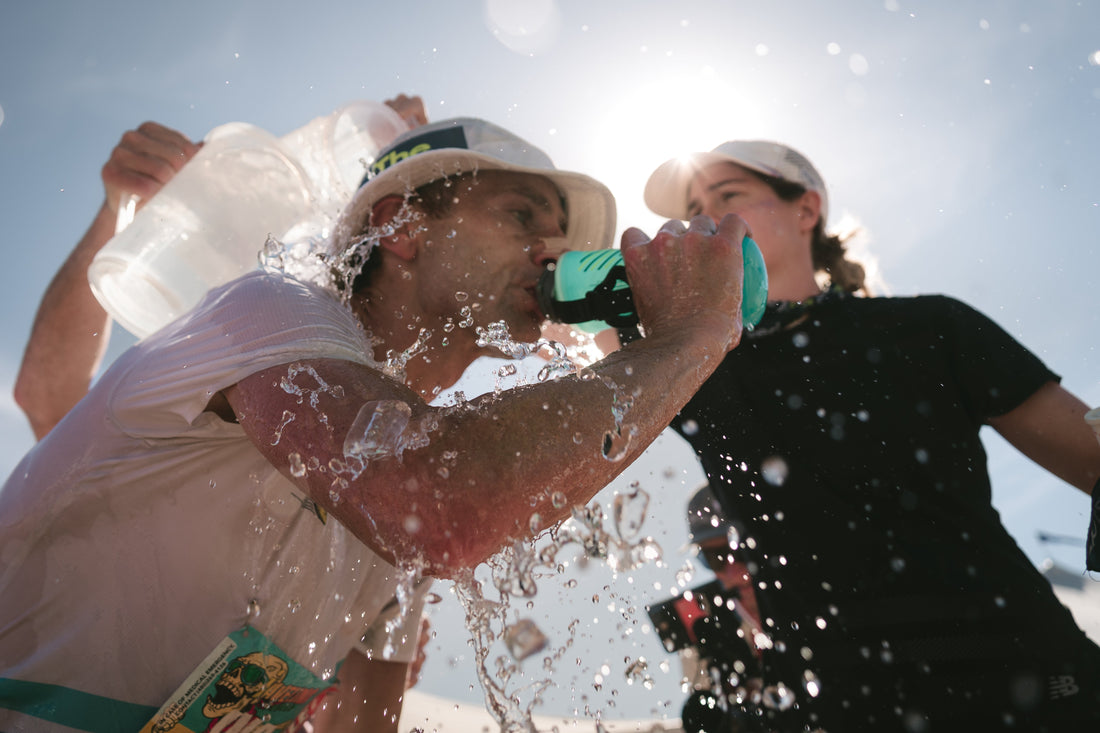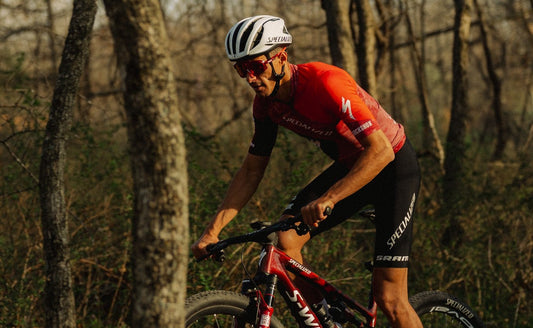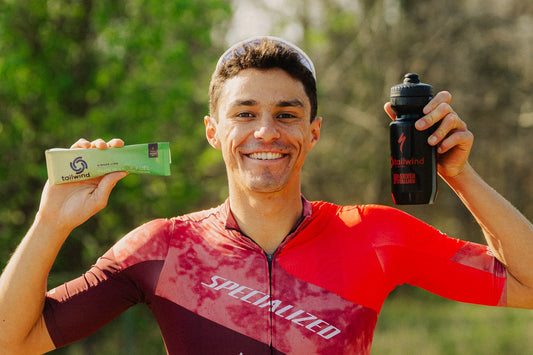The High-Carb Performance Revolution By David Roche
3 Comments
Across all endurance sports, the ground is fundamentally shifting beneath our feet. Running, cycling, and triathlon are all getting wildly faster, seemingly all at once. Performances that were considered legendary a few years ago would barely make top-10 lists now. What the heck is happening?
The only variable that connects all of the sports is simple: high-carbohydrate fueling. As recently as a few years ago, only the outliers were trying 90+ grams of carbs per hour during races and hard efforts. Then, a series of studies combined with the explosion of high-carb approaches in the pro cycling peloton to create a critical mass of evidence. At the core, the equation looks like this:
More carbs in hard training + more carbs in racing = adapt to higher levels and push harder for longer.
My co-coach Megan and I have lived the revolution. For years as a coach, we would see athletes have breakthroughs that seemed anomalous relative to their training, with a proto-version of high-carb fueling being the uniting factor for many of them. We talked about high-carb in writing and on our podcast, but we were always worried about overshooting the trajectory of the science, which mostly had recommendations between 60-75 grams of carbs per hour.
Around 2020, some of the original high-carb running studies emerged showing that up to 120 grams of carbs per hour, higher intakes led to less muscle breakdown, lower effort, better performance, and less fatigue on subsequent days. In the years since, studies have found that training with higher carbs improves next-day performance and adaptation, along with endocrine and nervous system status.
Those studies combined with stories from pro cycling and triathlon, where there were whispers of 120...130...even 150 grams of carbs per hour coinciding with international victories. Even though those stories weren’t published in peer-reviewed journals, it was clear that everything was changing when the cycling power numbers that would have competed for podiums at the Tour de France in the previous decade now would be dropped out of the pack.
The studies and emerging evidence from pro cycling let Megan and I scream our message from the rooftops to every runner who would listen: the carb revolution is coming.
But I think the revolution wasn’t fully obvious until 2024. Rod Farvard led the way with a dominant win at the Canyons 100k and breakthrough 2nd place at the Western States 100, where he raced from the front fueled by a high carb approach. His openness gave the entire sport space to dream. And I thought--I’m not just a coach. Let’s see what I can do as an athlete to help prove the high-carb concept.
I arrived at the 2024 Leadville 100 with a plan guided by the science. To beat a course record held by Matt Carpenter, a legend of the sport with one of the highest VO2 maxes ever measured, I couldn’t try to beat him in a fitness or training contest. I don’t have that fire. But I do have something that he didn’t--high-carb product advances that allow present-day athletes to consume so many more carbs so much more easily. Matt Carpenter had to blend power bars into a high-carb slurry. Companies like Tailwind are creating a different type of fire.
I took in 120-140 grams of carbs per hour for 15:26 to set the record.
While recovering from that race, I thought the same thing that a lot of commentators thought. Maybe it was a fluke, a lucky first try at 100s. So, 10 weeks later, I lined up at the Javelina 100 in record heat. This time, with a more liquid-based approach given the high fluid needs in that heat, I got up to 150 grams of carbs per hour on the way to a win and golden ticket to Western States.
Here’s the big thing that I cannot emphasize enough: if I’m running those times at Leadville and Javelina, there are athletes of the next generation who are going to go 30 minutes faster with high-carb. I’m a bit early to the revolution in ultrarunning, but we’ve already seen it in cycling and triathlon. The whole sport is about to be upended in ways that will shock anyone who isn’t paying attention.
I think that the big change coming over the next few years will be driven by technological advances that make high-carb fueling easy and tasty. Even if the previous generation knew about high-carb 10 years ago, I’m not sure it would have been possible with the viscous gels at their aid stations. In fact, the first time I tried to pilot this approach at an ultra in 2023, I took in one of those viscous gels during a long period without crew and immediately evacuated the contents of my stomach. At that moment, I realized that this is a tech problem as much as a science problem, and I set out to find the best products on the market.
I was skeptical when Tailwind sent their new high-carb drink mix. A benefit of our openness with high-carb is that we get sent a lot of carbs! But I like what I like, and I never want to risk a run trying something new. Plus, the higher-carb drink mixes I have tried haven’t been for me.
So the sachets of Tailwind sat in our pantry for a few weeks until a random Wednesday, when Megan came upstairs from an indoor bike workout in our Pain Cave. “That Tailwind is rocket fuel!” She didn’t want to take in any gels that morning, so she filled 2 bottles with Tailwind, 90 grams of carbs in each. She said that she felt like it had caffeine given how great she felt during and after her bike.
The next day, I tried it on a bike workout. Holy crap it was good--the lemonade flavor was so smooth, great tasting, and my 2 x 24 ounce bottles could get me through a 2-hour workout without needing any gels. Before heading down to the bike, I thought “I’m going to be drinking anyway, so why not add more carbs to the mix?” After breakthrough power numbers, I thought “That stuff is magic.”
Next, we experimented with long runs. I even tested it on my hardest training effort of the season, where I set the record on the infamous Gold Hill loop in Boulder in 2:04 fueling exclusively with Tailwind, with 60 grams of carbs in 3 x 16 ounce bottles. After it passed the ultimate stress test on Gold Hill, I didn’t hide my feelings when I messaged Tailwind back. “This stuff is magic. How can we help?”
The best part about promoting a high-carb product that I know works as well as Tailwind is that I’m promoting performance and health. The performance benefits are now unequivocal. No one who is in touch with the performance revolution is saying otherwise.
But even more importantly, adequate carbohydrate intake in training and racing makes the process of working hard so much more sustainable for athletes of all levels. There is less muscle breakdown, less physical and emotional stress, and for most athletes--better biomarkers in bloodwork. Tailwind high carb doesn’t just make us better athletes, it also makes us better parents the rest of the day. And this type of fueling is going to add a few years of peak performance to the end of our professional running careers because our bodies aren’t eating themselves trying to keep pushing through depletion.
Or to put it another way: the performance revolution is ongoing. With Tailwind High Carb, the weapons just got upgraded.
Written by David Roche
Cover Photo by Cody Bare Photography








3 comments
Hi, what ratio of glucose to Fructose is in the mix?
———
Tailwind Nutrition replied:
Hi Stephen! Tailwind High Carb Fuel is packed with 90g of carbohydrates in an optimal 2:1 glucose-to-fructose ratio
I have always used your Endurance Fuel, even running my first 100 with only that for calories. Since then, I have run races where I needed more, but struggle with eating. Could the high carb mix be the solution (no pun intended)? And is there a transition that is laid out so your body accepts all those carbs during a run? Thank youl.
———
Tailwind Nutrition replied:
Hi Valerie! Yes, on the High Carb Fuel product page, you will find a training guide on how to fuel with High Carb so that you can take in that many carbs, happy training!
I was looking for a list of ingredients in Tailwind fuels and didn’t see it on the website. Can you provide ingredient list for comparison to others such as Hammer and Crank Sports?
Thanks, Mike
———
Tailwind Nutrition replied:
Hi Michael, the list of ingredients is listed on each product we have on our site. If you scroll down where it says ‘the scoop’ there are two other tabs that say ‘ingredients’ and ‘nutrition facts’. The list of Ingredients for High Carb Fuel are: Dextrose (Anhydrous), Maltodextrin, Fructose, Citric Acid, Sodium Citrate, Sea Salt, Flavor (Organic Ginger Extract for Ginger Lime), Potassium Salt, Calcium Carbonate, Natural Flavor, Magnesium Oxide. Gluten free, vegan, dairy and soy free.